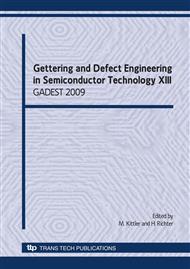p.369
p.375
p.381
p.387
p.395
p.401
p.407
p.413
p.419
Effect of Oxygen in Low Temperature Boron and Phosphorus Diffusion Gettering of Iron in Czochralski-Grown Silicon
Abstract:
Low temperature boron and phosphorous diffusion gettering (BDG and PDG) of iron in Czochralski-grown silicon were experimentally studied. Differences and similarities between the gettering techniques were clarified by using intentionally iron contaminated wafers emphasizing especially the effect of oxygen. Experiments showed that the surprisingly high gettering effects of BDG could be explained by B-Si precipitates. Oxygen precipitation was seen to decrease minority carrier diffusion length after long gettering at low temperatures in both BDG and PDG. In the case of BDG oxygen precipitation affected more as a higher thermal budget was needed to obtain similar sheet resistance to that of PDG. According to experiments the efficiency of BDG can not be concluded from the sheet resistance, whereas the efficiency of PDG can. This has practical influences in a process control environment.
Info:
Periodical:
Pages:
395-400
Citation:
Online since:
October 2009
Price:
Сopyright:
© 2010 Trans Tech Publications Ltd. All Rights Reserved
Share:
Citation:


